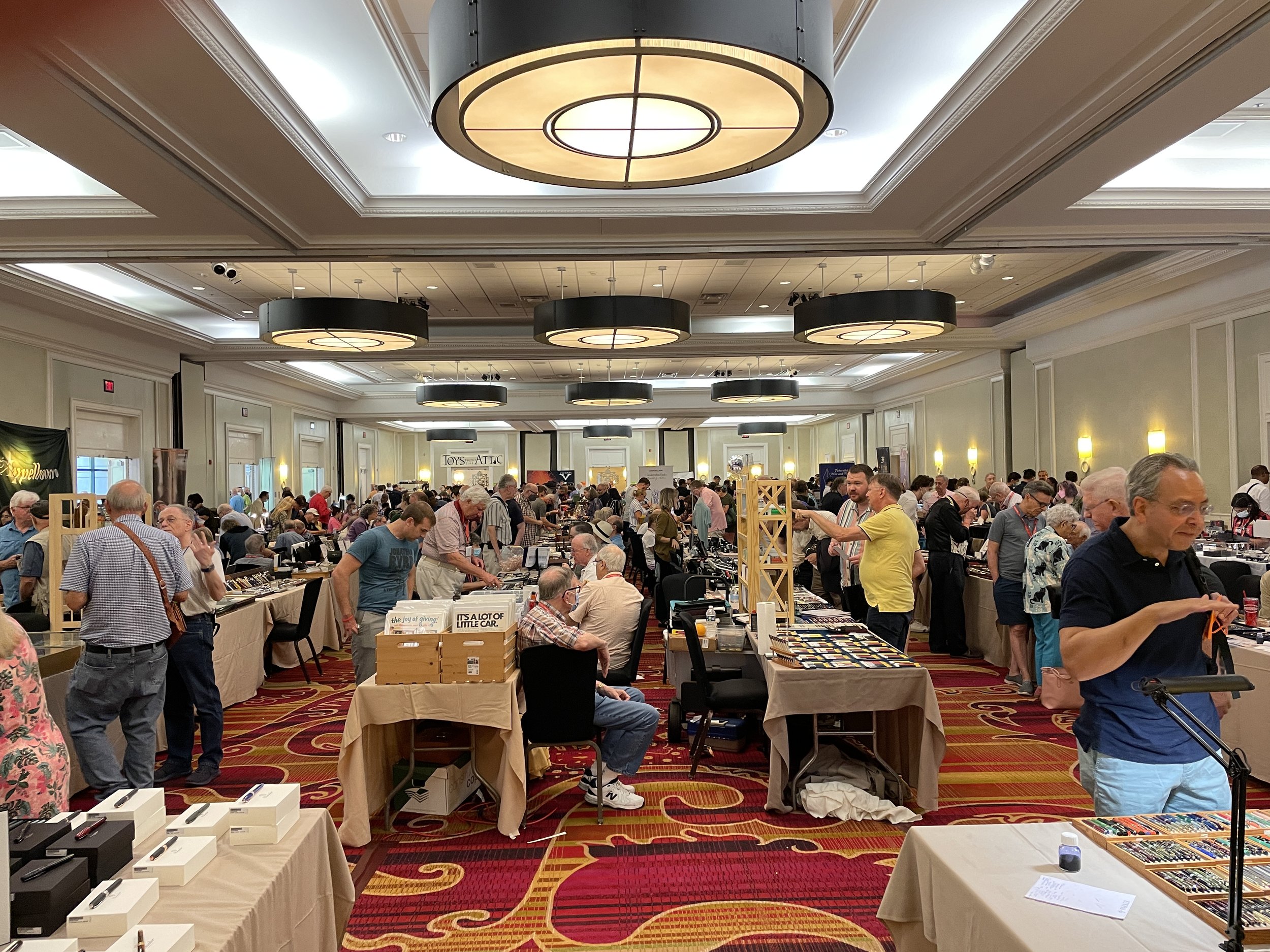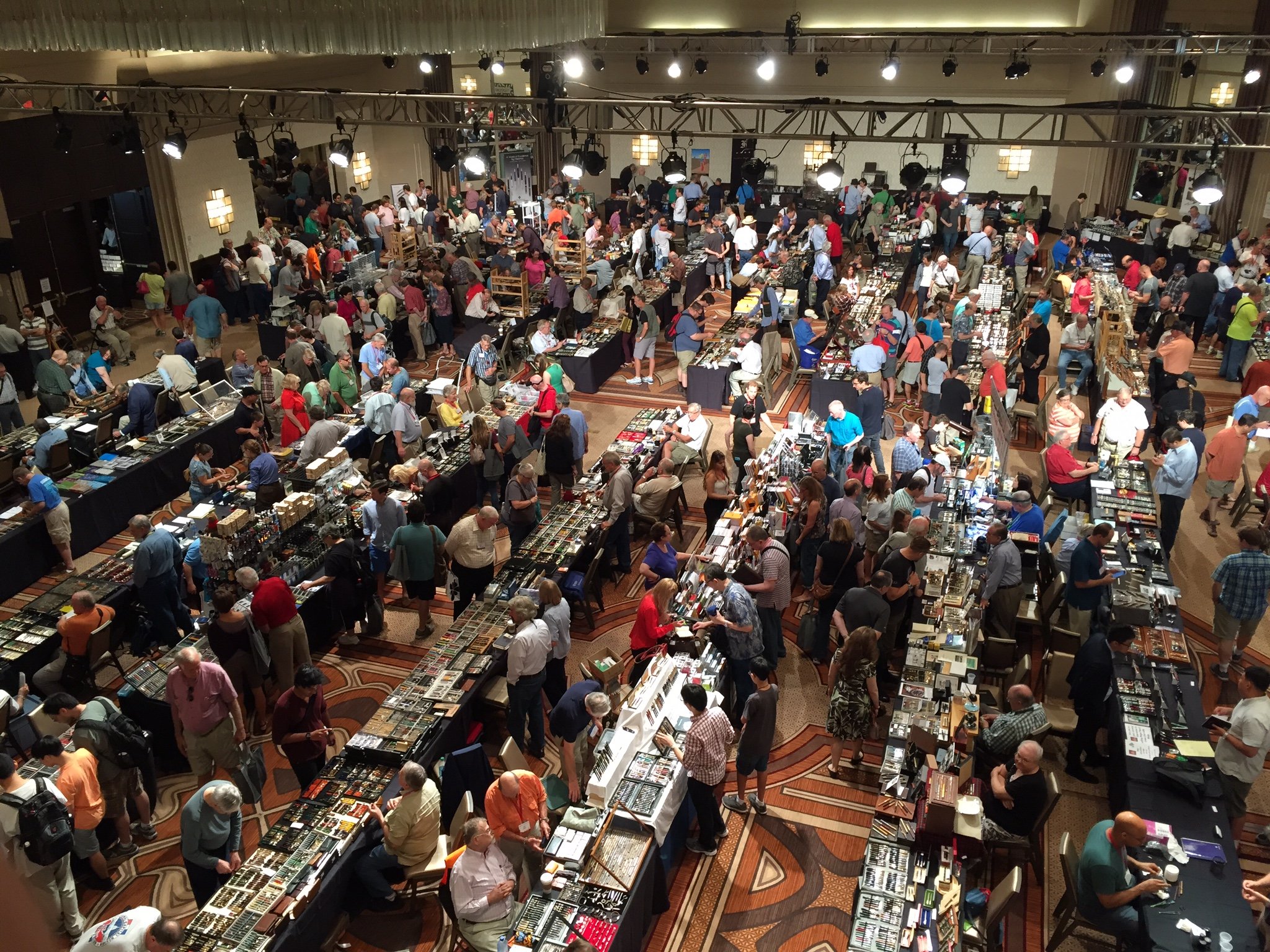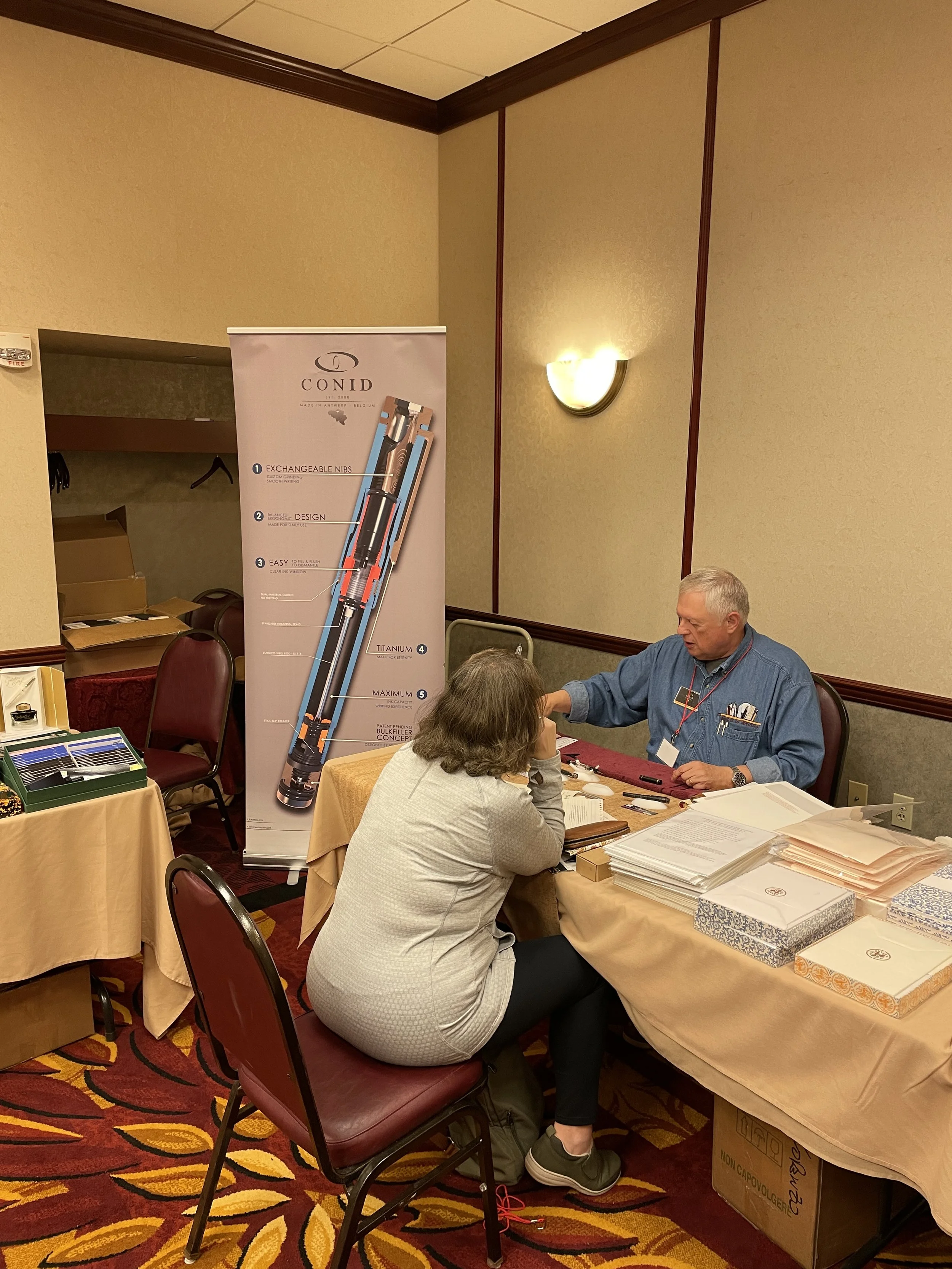For many people, the D.C. Pen Show has been, and always will be, “The Big Show,” (or “The Fountain Pen Supershow”, as it’s long been dubbed). For years, it billed itself as the premier pen event in the world, and certainly in the United States. It’s true - the D.C. Pen Show is quite large, and if what you’re looking to do is shop, it offers an unparalleled opportunity to meet makers, vendors, and retailers.
Shawn Newton had all kinds of custom pens available for in-person viewing (and purchase!) in D.C.
The issue I have is that I can’t stop myself from comparing recent D.C. Pen Shows - say 2018-present - with the shows from the mid-2010s, at the old location. I also can’t help comparing the D.C. Pen Show, in its current form, to the Baltimore and San Francisco Shows, all of which have maintained the “destination event” cachet that D.C. unfortunately seems to have lost. Certainly, some of this is beyond the control of the D.C. Pen Show and its organizers. The D.C. Pen Show gave up the rights to its old location after 2016, which I believe was the last show in Tyson’s Corner, after which the show moved to the Marriott Fairfield Park in Falls Church, Virginia. In the years since, there has been organizer turnover, with founder Bob Johnson passing away; the COVID pandemic, which forced cancellation of the 2020 show and continues to affect people’s willingness to travel; and this year, major construction at the hotel that closed the restaurant, deprived attendees of any real area to hang-out after-hours, and forced the show to operate on two different levels.
Aerial shot from the 2015 D.C. Pen Show.
Even after accounting for all of these logistical challenges, the D.C. Pen Show feels different than it used to, and the trend has been noticeable over the past several years. Fridays are much slower, with less visible foot traffic, even after they started opening the show to the public at noon. While Saturday this year was packed at points in the morning and mid-afternoon, there were times when it slowed down dramatically to levels I had not seen before on a Saturday in D.C. (While I had to leave the show on Sunday at noon, I don’t typically draw much of a conclusion from a show’s Sunday turnout, since last day traffic at any show is notoriously unreliable and always has been.) The majority of vendors I spoke with felt that both Friday and Saturday at the show were slower than usual and their numbers were down. This issue hasn’t been unique to D.C. - many people have expressed to me a general concern that attendance, as well as overall spend by attendees, has been declining at other shows as the year proceeds.
Schon DSGN brought the goods, as always!
How Much of The Change Is Driven by the Economy vs. Changes in the Pen Community and What We Expect from Pen Shows?
A big question I’ve been asking myself, over the weekend and in the days since, is whether the slowdown is the result of structural and economic factors, problems with how shows are run, or whether it represents a permanent shift in how people are attending and interacting at pen shows. Several people asked me for my opinion on “what the issue was” over the weekend, and I’m not sure I have a clear answer. I did spend some time thinking on possible factors contributing to lower traffic and sales, and this is what I came up with:
“It’s the Economy, Stupid.” You can’t ignore the effect of inflation, gas prices, travel chaos, and the lingering possibility of contracting COVID. People still aren’t traveling as much as they were in 2019, and certainly aren’t shopping as much, because they simply can’t afford to and are cutting back on discretionary travel and purchases. As much as we hate to admit it, things like pens, inks, and paper are largely discretionary purchases, and it’s difficult for many to justify taking an entire weekend at a hotel to attend what amounts to a three-day binge on pens. That said, I think it’s a mistake to write off all of these changes as “just the economy” and assume that things will return to the prior status quo once things go back to normal (whatever that is).
The Cost of this Hobby Is Rising. This is in part due to inflation, but also because in recent years manufacturers, retailers, and secondary market resellers have been pushing the boundaries of what people are willing to pay for pens. I’m not saying any particular cost is necessarily unjustified, but if the baseline price for a custom pen with a steel nib now pushes $250-300, if Sailor Pro Gears now cost $300+, if the new Esterbrook Camden “Polar Lights” is priced at $350 (I could go on), then people are understandably going to take their time in making a purchase, and will probably buy fewer pens overall, both at shows and online. What concerns me more is the secondary market and how the community interacts with it, raising the possibility that the pen community is in danger of becoming more like the watch community, where absurdly high secondary market prices on certain trendy pens and inks, as well as snobbery on the part of some of those who partake in the hobby, intimidate others from joining in the fun. (This is another post for another time.)
Some Shows No Longer Feel Like a Destination Event. In light of the economic constraints most people are feeling in their everyday lives, when they DO attend a show, they expect a lot from it. Not just in terms of opportunities to shop, but they also look for unique seminars, organized after-hours gatherings, and a friendly, welcoming environment focused on building a community. In my opinion, this is why the Baltimore and the San Francisco Pen Shows have continued to thrive. If anything, this year in D.C. confirmed that a pen show without a central gathering point for attendees, such as a functional lobby bar or easily accessible restaurants, is not an event that I enjoy attending. Sure, people attempted to organize smaller events after hours, but in a few instances these were done in a way intended to create the perception of an “in-crowd,” or the events/gatherings were dropped to select people on an “invite only” basis to create an air of exclusivity. That’s not what this community has ever been about (at least for me).
“Waves” of New Hobbyists/Enthusiasts Are Still Finding their Niche. A LOT of people discovered, or rediscovered, pens and inks during the Pandemic, when they were spending more time at home. Until relatively recently, their only interaction with the community was online. Many have shown up at their first pen shows, and have absolutely no idea what to do and where to go, how much things should cost, etc. It’s only natural to have some hesitation. We need to focus on creating a welcoming atmosphere at shows for new community members, and give them a reason to keep coming back to shows, as opposed to griping that the newbies “aren’t buying anything.” That will happen, as long as they stay in the hobby and want to keep coming back. Personally, it took me at least two shows to feel comfortable. In a way, I feel like we are “between waves” of new enthusiasts entering the hobby. Many of the “experienced” crowd that attends pen shows discovered pens in the mid-2010s, and are now scaling back on acquisitions because they are in a place where they (1) have nearly all of the “standard” pens in their collection they could ever want or reasonably use; and (2) are selective in terms of what they add to their collection. As I mentioned above, the new customers who would take their place are still finding their footing, and this will take time.
This year’s haul from the D.C. Show, focusing on brands I’ve not yet experienced, including Troublemaker Inks and Gravitas Pens, who where attending from Ireland.
What’s Next for Pen Shows?
The San Francisco Pen Show takes place at the end of August, and last year’s show was one of the best I’ve attended, despite COVID and fires and other logistical challenges. While San Francisco offers an excellent opportunity to shop from a wide array of vendors, it also has free seminars and after-hours events in the hotel for weekend attendees. I have a reservation to attend, and barring any last minute work or family conflicts, I plan to be there. I’m looking at this year’s pen show calendar as a sort of experiment documenting what works, and what doesn’t work, in a “new normal” environment and a community that continues to evolve.
I’ll close by saying this - if there’s a show you enjoy, and that you want to continue, go to the show, buy a weekend pass if you can, and support the vendors who attend. That does not necessarily mean that you need to spend a ton of money, or even that you purchase something on-site. If you value pen shows, however, you should make an effort to buy from those retailers who do attend the shows (nearly everyone sells online these days), invest their own time and money in making it a great experience, and when you do, let them know that you met them at the show, saw their work or table, and that the show played a role in your decision to buy from them. I suspect a lot of people are questioning whether its worth it to continue to attend every show, or shows in general, and this sort of feedback is invaluable.
I enjoyed actually just having samples on-site in D.C., relying on the website to actually conduct any sales, which freed me up to visit with attendees and other vendors. I enjoyed meeting many of you! The cases I had at my table were made by Lochby, one of the main lines we carry, and I have links to all products saved in my Instagram Story Highlights.
T.G.S. Will NOT Have a Table in San Francisco
Assuming I’m at the San Francisco Pen Show later this month, I will be attending in my personal capacity. For those of you who picked up a T.G.S. Pen Show Promo Code at the table in D.C., it will be valid through 11:59pm on Sunday, August 21. If we met at the show and you picked up a card and lost it, just contact me through social media or via the “Contact” link on the blog and I will send you the code. (Honor System - Don’t share, as I want to maintain something special for show attendees. I do plenty of general promos for everyone throughout the year.)
The Gentleman Stationer is supported entirely by purchases from the T.G.S. Curated Shop and pledges via the T.G.S. Patreon Program.




